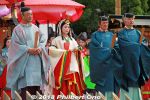|
|

Matchlock gun demo at Azuchi Nobunaga FestivalMore pictures here.
|
|

Demonstration of matchlock guns, Azuchi Nobunaga Festival.Even these people had to obtain police permission to bear and fire these feudal-era guns.
|
|

Boat ride along the moat of Azuchi Castle.
|
|

Ahoy there!
|
|

Hie Shrine's Sanno Matsuri Jinko-sai Procession in front of Imperial Palace.
|
|

Flower float, Sanno Matsuri
|
|

Oda Nobunaga 織田信長
|
|

Ishida Mitsunari 石田三成
|
|

The procession passes by Tatsumi Turret as it leaves the Imperial Palace.
|
|

A mikoshi passes by Tatsumi Turret of the Imperial Palace durng the Sanno Matsuri Jinko-sai.
|
|

Parish members wait for the portable shrines to arrive. The paper lanterns are written with the names of the parish.
|
|

Hie Shrine Sanno Matsuri
|
|

Horikiri Iris Garden, Katsushika, Tokyo
|
|

The Departure Ceremony at Saiku Heian-no-mori Park gathered all the people in traditional costume. 出発式Saiku Heian-no-mori Park (Saiku Heian Era Park) recreates one of the many rectangular blocks of the Saiku Palace area. This one reconstructs three buildings used by the head of the Saikuryo, the government office of the Saiku Palace. This main building is the Seiden (正殿) dating from the 9th century used to conduct important ceremonies by the head of the Saikuryo and to welcome official messengers from Ise Grand Shrines and Kyoto. Saio Matsuri is a tourist/community festival, not a religious festival held by any shrine. Run by a volunteer committee.
|
|

Everyone here are volunteers, includng the festival staff behind the scenes. The festival is directed by a group (named Komachi 小町) of former Saio princesses and other characters who train the current year's festival participants.
|
|

Ranryo-o court dance dating to the Nara Period (8th century). Chinese warrior Ranryo-o was Prince of Lanling (Gao Changgong), a victorious 6th c. general. (舞樂蘭陵王).To hide his gentle-looking face, Ranryo-o wore a fierce mask in battle. Notice the dragon head mask.
|
|

This is the Saio princess sitting in a palanquin on wheels. In Saiku, the Saio's palanquin is called Sokaren (葱華輦), meaning "Onion Flower Palanquin" in reference to its onion-shaped giboshi roof ornament.The Saio palanquin bearers are called Kayocho (駕輿丁) who were chosen from the best gentlemen.
|
|

Saio princess in a palanquin in Meiwa, Mie Prefecture. The Saio princess was selected from tens of candidates. This was her fourth time to apply for the honor and she was finally selected.It is to promote the town so she was very willing to pose for pictures. The makeup person did a very good job.
|
|

Saio princess in a palanquin in Meiwa, Mie Prefecture.
|
|

The man on the far right in dark blue is Ise Kokushi (伊勢国司) Governor of Ise Province. Next to him also in blue is the Chobusoshi (長奉送使) director of the Saio procession.
|
|

After the arrival ceremony, they held a picture-taking session with the Saio princess who posed with each group of characters. Anyone could take pictures. This was a great PR strategy. Obviously, social media fodder. Got some good photos of everyone.
|
|

Katsushika Iris Festival at Mizumoto Park in full bloom.
|
|

Taume rice planters at the Taga Taisha Rice-planting Festival. 田植女
|
|

Oyushiki ceremony is performed to purify the sacred rice paddies during the Taga Taisha Rice-Planting Festival. 御湯式
|
|

Taume rice-planting girl at Taga Taisha Rice-planting Festival, Shiga Prefecture.
|
|
|
|
|
|
|